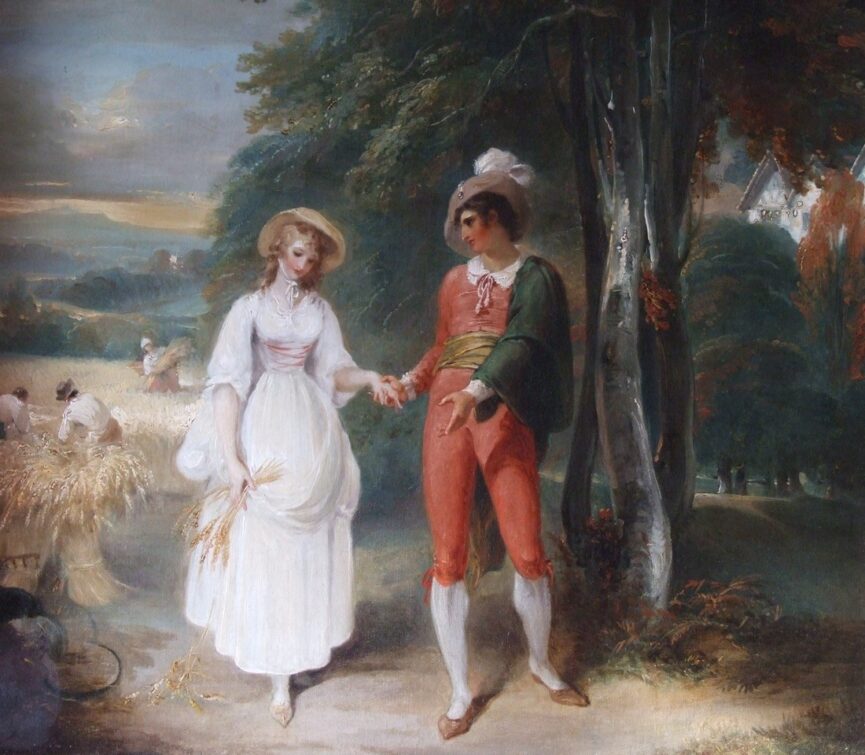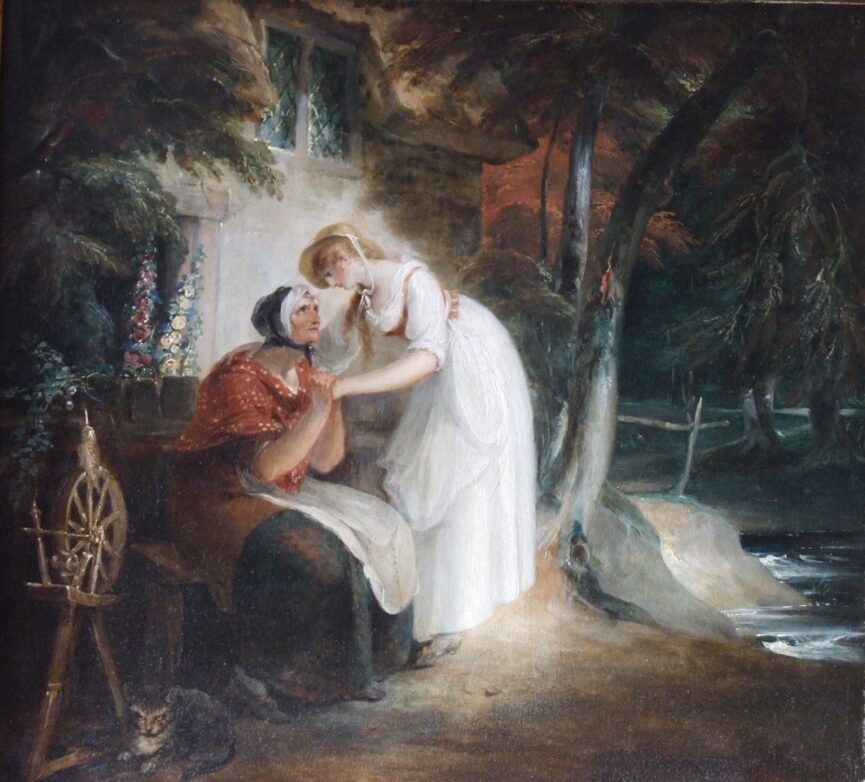William Hamilton, RA
(1751-1801)Lavinia and her Mother; Lavinia and Palaemon; a pair
Oils on canvas, both signed with initials and dated 1795 Sizes, of the first: 18½ x 20½ inches, the second: 17 ¾ x 20 inches In their original gilded frames.
Provenance: Exhibited:
Royal Academy 1795, nos 215 & 227
Exhibition of Old Masters, Chester, August 1879
Provenance:
Sale Christie’s London, 1858
Sale Christie’s London, 1879
Victor W Morris Esq
Sale Christie’s London, 1985 purchased by
Richard Feigen & Co New York, by whom
sold to a private collector, Park Avenue
by whom sold.
Engraved:
By Tomkins/ Bartolozzi (the first with alterations)
Literature:
Noted in The Diary of Joseph Farington
“He saw her charming, but he saw not half
The charms her downcast modesty conceal’d” Thomson
These scenes are taken from ‘The Seasons’ by James Thomson. Published between 1726 and 1730, these poems inaugurated a new style in English poetry with their vivid evocation of man’s interaction with nature and animals. So-called ‘history’ painting was considered the highest form of art and several Eighteenth Century artists produced works based on this and similar themes. History painting continued into the 19th Century, but also influenced the vogue for rustic and genre, as painted by George Morland and his followers.
William Hamilton was born in Chelsea, probably in Paradise Row, a small street near the Physic Garden. His father was assistant to Robert Adam, and the Hamiltons accompanied him to Italy, leaving in 1754 and returning about seven years later. Whilst there, Adam had met the decorative artist Antonio Zucchi, whom he persuaded to come to London in 1766. Two years later, when he was 17, William Hamilton became Zucchi’s student and they travelled briefly to Italy before Hamilton enrolled in the R.A. schools in 17692. Hamilton first exhibited at the R.A. in 1774 and was elected an Academician on 1788.
William Hamilton was considered one of the leading history painters of his day; he produced numerous pictures for both Maklin’s and Boydell’s Shakespeare Galleries, and provided illustrations for a number of books, including Pope’s Rape of the Lock and a famous Maklin eight volume edition of The Bible. He was additionally employed at Fonthill, Arundel Castle, Longleat, Kedleston and Highcliffe (both part of Adam interiors) and also worked on the decoration for the great rotunda in the Vauxhall Gardens.3 Hamilton only infrequently painted portraits, two of which (of John Wesley, and Francis Wheatley) are in the National Portrait Gallery. He did, however, paint a number of leading actors including Kemble and Sarah Siddons in costume.
At the Royal Academy, where he exhibited a total of 82 pictures4, Hamilton was an active member, attending most meetings and dinners and supporting the election of, amongst, others, Lawrence, Hoppner, Beechey, Gilpin and Flaxman. He was a friend of Farington, worked with Fuseli (on an edition of The Seasons), Smirke and Wheatley; he courted Angelica Kauffmann (who eventually married Zucchi) whilst a student in Rome, dined with William Beckford “2 or 3 times a week”5 and taught drawing to his daughters at Fonthill. He lived in Dean Street, Soho, from 1776 and died there of a fever in December 1801. He is buried in St Anne’s Church, Soho, a lovely Wren church, sadly mostly destroyed by a bomb in 1940.
Today, William Hamilton’s work can be found in most major galleries in the UK, a number of American collections, museums in Australia and France, the Royal Collection, several Theatrical museums and many stately homes.
1 The Diary of Joseph Farington, RA. Reprinted, Yale 1978-1984, Index volume, 1998
2 This information distilled from the accounts given in: E.Croft-Murray, Decorative Painting in England, Vol II p217 (Country Life Books, 1970) and Col. M.H.Grant, The Old English Landscape Painters, Vol IV, pp286-7 (reprint, Lewis, 1959)
3ibid. (Croft-Murray) Contains description of his various decorations in these and other houses
4Dictionary of Artists exhibiting…. Algernon Graves, 1884. (Kingsmead facsimilie edition 1969)
5see Farrington Diaries, Vol IV p1308


